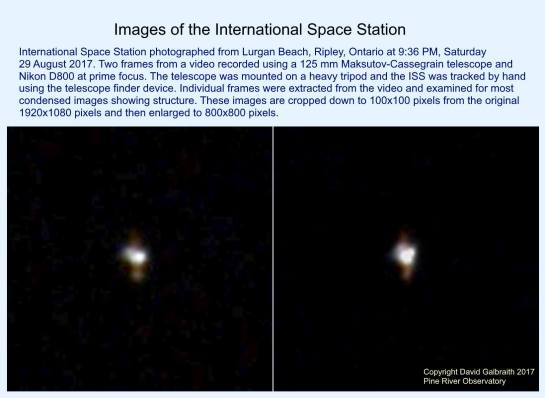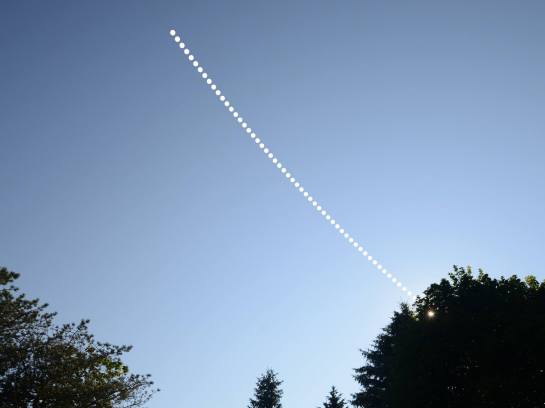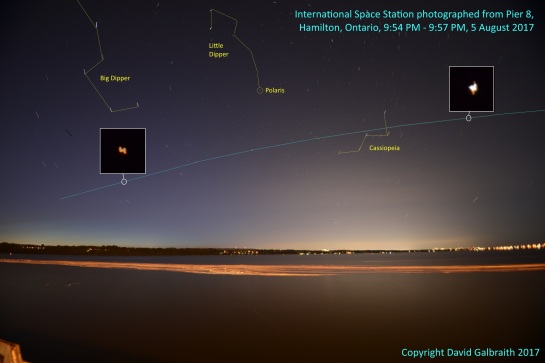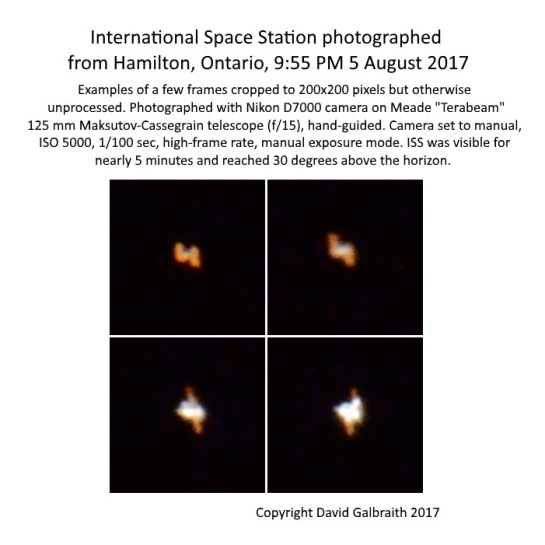The idea of being able to take a photograph of the International Space Station is enchanting. Here’s one of humanities’ greatest achievements, passing by very frequently and yet so far out of reach to those of us on the ground.
Taking photos of the ISS is perfectly possible from the ground, but it requires some preparation. First, you have to know how to find it. There are several smartphone apps and on-line sites that allow you to predict when and where the ISS will be visible from your location. I use ISS Spotter on an iPhone, which I find very handy.
Once you know where it is going to be you have to think about how to capture it. The ISS typically crosses a section of the sky at a rate of between 1 and 3 degrees per second. This doesn’t sound too fast, but when you realize that it’s about 100x faster than computerized telescope mounts move you get some idea of the challenge. Even a large consumer telescope on a computer mount just can’t keep up.
It IS possible to follow the ISS and other satellites using computerized telescope mounts, but they’re not off-the-shelf gear. An absolute master at this kind of photography is Thierry Legault, an engineer based in Paris, France. Thierry’s systems include modified mounts that can turn at the phenomenal speeds needed to track a satellite. Take a look at his images and his methods at: http://www.astrophoto.fr/
My equipment isn’t up to that sort of approach, but you don’t need to that way. Instead, I’ve tried mounting my 125mm Meade Terabeam Maksutov-Cassegrain telescope on a photographic tripod. This arrangement (see the photo) is easily carried in one hand. It depends on being able to use the finding device (in this case a Rigel Systems QuikFinder reflex sighting device) to follow the target. Using this simple set-up it’s possible to follow the target and take numerous photos or shoot video, and them examine the resulting images later for any that worked out. This is an approach related to “Lucky Imaging” that is commonly used in more sane corners of amateur astronomy.

My ISS-hunting rig. I’ve mounted a Nikon dSLR camera at prime focus on a 125 mm Meade Terabeam Maksutov-Cassegrain telescope. This is then set up on a heavy-duty photography tripod. This telescope is equipped with a red-circle Rigel Systems QuikFinder (http://rigel.datacorner.com/rigelsys/quikfinder.html )
Of course I am using the term “sane” in a tongue-in-cheek manner here and mean no disrespect to those suffering from mental disabilities. It’s just the term that came to mind as I snapped away at the space station like a field gunner trying to shoot down an Sopwith Camel during the First World War.
There are a couple of very basic set-up steps that deserve every bit of attention before the pass begins.
First, ensure that your finding device is well-aligned with the telescope itself. You will not be looking through the telescope or camera to take these photos. You’re flying blind, relying on the finder to set things up. You are adjusting the aim of the telescope throughout the entire pass. The steadier the better, but you still must keep moving to keep the ISS as close to the telescope’s centre of view as possible.
Second, focus is crucial. The ISS is tiny from earth – just a few arc-seconds across. Before the pass focus the telescope as carefully as possible on a star. This is a little easier said than done without having the telescope on a capable telescope mount. I used the moon and also very distant lights to try to focus the spot mac.

While I was setting up to shoot the ISS I snapped this distant jet high over Lake Huron. Possibly 30 km or more away.
Keep in mind too that if you are using a dSLR your camera is going to shake like made when the mirror and shutter are activated. Every bit of extra motion is a problem. I think an ideal imager for this application would be a mirrorless camera with a full-frame sensor, but I’m not quipped with one of these.
For my first try I used a Nikon D800 camera on video mode. I started running the video before the ISS came into view, and simply kept the telescope pointed at it, moving as smoothly as I could, throughout the pass. Afterward I then exported all of the images using IrfanView, and threw out everything that wasn’t a recognizable image. In other words, nearly all of the resulting frames.

Just for the focus. I used the moon as a target to focus the telescope prior to the pass of the ISS on 29 July 2017 visible from the mouth of the Pine River.
Despite all of the make-shift arrangements, at the end of the day I did capture something with structure. Here are a couple of frames:

I’ve seen some authors recommending this approach with telescopes on Dobson mounts. This makes a lot of sense too, as these mounts are intended to allow you to point the telescope by hand with ease. I will try to take more images of the ISS as time and opportunity permits. It’s a fascinating subject!
Copyright 2017 David Galbraith














